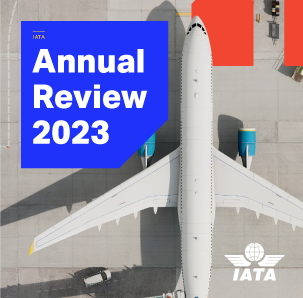
Translation:
国际航协:确保 5G 网络的安全部署 (pdf)
Pour assurer le déploiement sécuritaire des réseaux 5G (pdf)
Garantizar el despliegue seguro de las redes 5G (pdf)
IATA pede apoio de governos para garantir a implementação segura das redes 5G (pdf)
Doha - The International Air Transport Association (IATA) urged governments to work closely with the aviation industry to ensure that aviation and incumbent aviation safety systems can safely co-exist with new 5G services[i]. While IATA recognizes the economic importance of making spectrum available to support next generation commercial wireless telecommunications, maintaining current levels of safety of passengers, flight crews, and aircraft must continue to be one of governments’ highest priorities. The call came as the industry was meeting in Doha, Qatar at the 78th IATA Annual General Meeting.
“We must not repeat the recent experience in the United States, where the rollout of C-band spectrum 5G services created enormous disruption to aviation, owing to the potential risk of interference with radio altimeters that are critical to aircraft landing and safety systems. In fact, many countries have successfully managed to facilitate the requirements of 5G service providers, while including necessary mitigations to preserve aviation safety and uninterrupted services. These include, for example, Brazil, Canada, France and Thailand,” said Willie Walsh, IATA’s Director General.
Before deciding on any spectrum allocations or conducting spectrum auctions, IATA called for governments to ensure close coordination and mutual understandings between national spectrum and aviation safety regulators so that each frequency allocation/assignment is comprehensively studied and is proven not to adversely impact aviation safety and efficiency. Robust testing in coordination with aviation subject matter experts is critically important in providing necessary information.
Measures that have already been used by some governments include:
- Ensure thorough testing, sufficient spectrum separation between 5G C-band deployments and 4.2-4.4 GHz frequency band used by existing radio altimeters
- Clearly codify and enforce the maximum power limit for 5G C-band transmission and downward tilting of 5G antennae particularly in the vicinity of flightpaths
- Establishment of sufficient 5G C-band prohibition and precautionary zones around airports
IATA noted that airlines operating to/from and within the US continue to contend with the effects of the rollout of 5G, including a pending airworthiness directive from the Federal Aviation Administration requiring them to retrofit/upgrade radio altimeters at their own expense to enable the respective aircraft to continue to utilize CAT II and CAT III low-visibility approaches at many US airports where 5G C-Band service is currently or will be deployed in future. The timely availability of upgraded altimeters is a concern, as are the cost of these investments and the lack of certainty regarding the future spectrum environment. Furthermore, 19 additional telecommunications companies are scheduled to deploy 5G networks by December 2023.
“FAA’s unilateral decision to require airlines to replace or upgrade their existing radio altimeters – which are approved by both the FAA and the US Federal Communications Commission – by July 2023 is deeply disappointing and unrealistic. The FAA has not even approved or certified all the safety solutions that it will require, nor have systems providers been able to say with certainty when the equipment will be available for much of the fleet. So how can there be any confidence in the timeline? Furthermore, FAA can provide no guarantee that airlines will not have to carry out further upgrades to radio altimeters as even more powerful 5G networks are deployed in the near future. Safety is our highest priority, but it cannot be achieved with this rushed approach. The FAA needs to continue working with all stakeholders collaboratively and transparently, including the FCC and the telecom sector, to define solutions and deadlines that reflect reality,” said Walsh.
The International Civil Aviation Organization (ICAO) and the International Telecommunications Union (ITU) both have recognized and reminded their Member States and Administrations of the importance of ensuring that existing aviation systems and services are free from harmful interference.[ii] This will become even more critical as more and more spectrum is being allocated to new generation telecommunications services.
For more information, please contact:
Corporate Communications
Tel: +41 22 770 2967
Email: corpcomms@iata.org
Notes for Editors:
- IATA (International Air Transport Association) represents some 330 airlines comprising over 80% of global air traffic.
- You can follow us on X for announcements, policy positions, and other useful industry information.
- Fly Net Zero
- Annual General Meeting 2024 media kit
- [i]The primary concern is when 5G C-Band antennas are transmitting near airports or approach flightpaths. The interference impact is roughly a function of the power of the 5G transmitters; proximity of the 5G transmitters to aircraft; and the spectrum separation to radio altimeters spectrum (how close in MHz). This interference could affect numerous critical onboard safety-related systems as well as aircraft precision landing & auto-land capabilities.
- [ii] “As the radio spectrum is divided into frequency bands allocated to different radiocommunication services, each band should be used only by the allocated services with established technical condition so that they can coexist with each other without creating harmful interference to adjacent services.” (ITU Fifth Generation of mobile technologies) “I encourage you and your Administration to consider as a priority, public and aviation safety when deciding how to enable cellular broadband/5G services in radio frequency bands near the bands used by radio altimeters.” (Fang Liu, ICAO Secretary General, ICAO State Letter, 25 March 2021)

